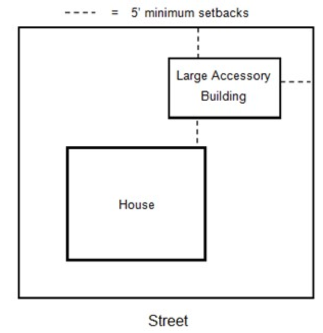Accessory buildings require a permit and a fee in an amount determined from time to time by resolution of the city council.

A. Accessory Building, Large: A building greater than seventy-five (75) square feet subordinate to the principal use of a building on the lot and serving a purpose customarily incidental to the use of the principal building.
1. Location: Large accessory buildings may be erected in rear yards only. For commercial and multi-family developments, large accessory buildings may be permitted in any yard subject to site plan approval.
2. Setbacks: Setbacks for large accessory buildings shall be no less than five (5) feet from a principal building or any other large accessory building. Large accessory buildings shall be at least five (5) feet from side and rear lot lines. See figure 11-4-7.1. Large accessory buildings six hundred (600) square feet or larger shall meet the setback requirements of the principal building.
3. Design Characteristics: Large accessory buildings shall be constructed of materials similar to the principal structure, and in character with the surrounding built environment, as determined by the community development director. For commercial and multi-family developments, design characteristics shall be subject to site plan approval.
B. Accessory Building, Small: A building seventy-five (75) square feet or less subordinate to the principal use of a building on the lot and serving a purpose customarily incidental to the use of the principal building.
1. Location: Small accessory buildings may be erected in rear yards only.
2. Setbacks: Small accessory buildings may be placed next to primary or large accessory buildings. Small accessory buildings shall be at least five (5) feet from rear lot lines.
3. Design Characteristics: Small accessory buildings are not required to conform with design standards that apply to primary and large accessory buildings. Small accessory structures must be constructed with durable outdoor materials.
C. General Standards: The following shall apply to all accessory buildings:
1. Corner Lots Or Double Frontage: In the case of a corner lot or a double frontage lot, accessory buildings with floor area greater than seventy-five (75) square feet shall not be located in the primary or secondary front yards. Accessory buildings with floor area less than or equal to seventy-five (75) square feet are permitted to encroach into the secondary front yard. In this case, the “secondary front yard” is defined as that yard that fronts on a public street or ROW, but does not contain the main entrance to the principal structure. See figure 11-4-8.3 in section 11-4-8 of this chapter.
2. Principal Building Relationship: Accessory buildings, except buildings housing animals or fowl, may be erected as part of the principal building or may be connected thereto by a breezeway or similar structure, and such accessory building shall be considered as part of the principal building for all yard requirements and building codes.
3. Height: No accessory building shall exceed one story or fifteen feet (15') in maximum height.
4. Accessory buildings shall not be constructed in such a way as to impede drainageways or interfere with overland flowage easements.
5. Principal Building Constructed: No accessory building shall be constructed on a lot until the construction of the main building has begun, and no accessory building shall be used unless the building official has issued a certificate of occupancy for the principal building. An accessory building may be constructed on a lot without a principal building provided the following conditions are met:
a. A principal building is located on an adjacent lot.
b. The lot containing the principal building and the lot with the accessory building shall have the same owner.
c. The lot containing the principal building and the lot with the accessory building shall be bound by a recorded lot tie agreement. (Ord. 1098, 1-28-2021)